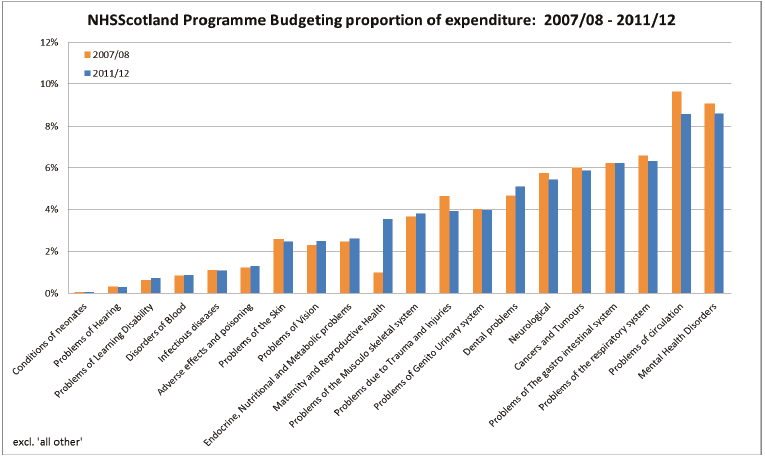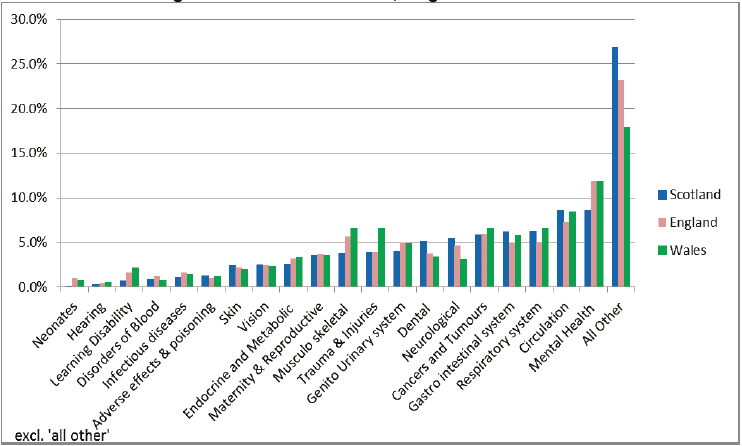Programme Budgeting in NHSScotland
A disaggregation of NHSScotland activity and costs by 23 diagnostic categories.
Expenditure
5. The highest spending categories identifiable were mental health disorders, problems of circulation and respiratory problems. In common with England, the biggest spend was in the programme ‘other’, which incorporates much of the community activity in Scotland as well as other activity that cannot be allocated by diagnostic category.
6. Table 1 shows that the distribution of spend across diagnostic categories in 2011/12 was very similar to 2007/08. The spend for 2 of these categories (“Healthy Individuals” and “Social Care Needs”) are included in the spend for the “Other” category”.
Table 1: Distribution of estimated spend by PB category (in £m) : NHSScotland 2011/12 and 2007/08
| Programme Budgeting Category code | Programme Budgeting Category | All services (£m) | Percentage 2011/12 (%) | 2007/08 (%) |
|---|---|---|---|---|
| 1 | Infectious Diseases | £99.2 | 1.1% | 1.1% |
| 2 | Cancer & Tumours | £545.4 | 5.9% | 5.9% |
| 3 | Disorders of Blood | £78.5 | 0.8% | 0.8% |
| 4 | Endocrine, Nutritional & Metabolic Problems | £242.2 | 2.6% | 2.4% |
| 5 | Mental Health Problems | £798.9 | 8.6% | 9.0% |
| 6 | Problems of Learning Disability | £66.1 | 0.7% | 0.6% |
| 7 | Neurological | £505.6 | 5.4% | 5.4% |
| 8 | Problems of Vision | £231.0 | 2.5% | 2.3% |
| 9 | Problems of Hearing | £26.7 | 0.3% | 0.3% |
| 10 | Problems of Circulation | £796.6 | 8.6% | 9.4% |
| 11 | Problems of the Respiratory System | £586.6 | 6.3% | 6.3% |
| 12 | Dental problems | £474.1 | 5.1% | 4.6% |
| 13 | Problems of the Gastro Intestinal System | £577.9 | 6.2% | 6.0% |
| 14 | Problems of the Skin | £228.7 | 2.5% | 2.5% |
| 15 | Problems of the Musculoskeletal System | £353.5 | 3.8% | 3.6% |
| 16 | Problems due to Trauma and Injuries | £362.8 | 3.9% | 4.4% |
| 17 | Problems of the Genito Urinary System | £367.3 | 4.0% | 3.9% |
| 18 | Maternity and Reproductive Health | £328.9 | 3.5% | 1.0% |
| 19 | Conditions of Neonates | £3.8 | 0.0% | 0.0% |
| 20 | Adverse Effects and Poisoning | £118.3 | 1.3% | 1.1% |
| 21 – 23 | All other Areas of Spend (inc. unclassified) | £2,490.1 | 26.8% | 29.3% |
| Total | £9,282.2m | |||
Source: ISD data request & analysis
7. The increase in the percentage spend on maternity between the 2 sets of data is because in the initial analysis it was not possible to map all maternity activity to that programme. This has now been rectified. The reduction in “other” is also due to the ability, for 2011/12 data, to allocate “accident and emergency” activity to relevant programme codes. For the 2007/08 data it was included in the “other” category.
8. Figure 1 illustrates this distribution of spend , excluding the category “Other”.
9. In common with the data presented in the Costs Book[5] the programme budgeting exercise demonstrates that the majority of the spend is within the hospital sector. Table 2 illustrates this. Table A1 in the Appendix further disaggregates the spend shown in table 1 across the sectors identified in table 2.
Figure 1: Distribution of NHS Scotland spend by programme budget (excludes “other”)

Source: ISD data request & analysis
Table 2 : estimated cost by sector NHS Scotland 2011/12 (£m)
| Hospital sector | |
|---|---|
| Acute Service | £3,109.2 |
| Geriatric Long Stay | £133.1 |
| Maternity Services | £251.9 |
| Mental Health & Learning Disabilities | £600.5 |
| Outpatient Services | £1,038.2 |
| A&E | £175.1 |
| Hospital sector sub total | £5,308.0 |
| Community | |
| Community | £1,558.7 |
| Family Health Services | |
| Pharmaceutical Services | £1,181.4 |
| General Medical Services | £747.1 |
| General Dental Services | £389.0 |
| General Ophthalmic services | £97.8 |
| FHS sub total | £2,415.4 |
| Total: all services | £9,282 million |
10.The distribution of spend across the programme budgeting categories in Scotland, England and Wales in 2011/12 is shown in Figure 2.
Figure 2: comparison of distribution of spend across programme budgeting categories 2011/12: Scotland, England & Wales

Source: Scotland, ISD request: England, Programme Budgeting Aggregate PCT Expenditure for all programmes and subcategories for financial years 2003/04 to 2012/13[6] . Wales, NHS expenditure by programme budget category: 2008-09 to 2012-13[7].
11.As can be seen from figure 2 the distribution of spend is similar across the 3 countries. Differences will be due to disparities in both supply of and demand for health care: and in data collection methods (e.g. in the Welsh data spend on GMS is included in the “other” category, in the Scottish analysis it has been possible to allocate activity, and cost, across the programme budget categories). The data used in this chart is shown in table A3 in Appendix A.
Contact
Email: Steven Gillespie
There is a problem
Thanks for your feedback